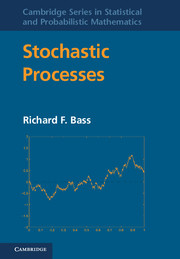Book contents
- Frontmatter
- Contents
- Preface
- Frequently used notation
- 1 Basic notions
- 2 Brownian motion
- 3 Martingales
- 4 Markov properties of Brownian motion
- 5 The Poisson process
- 6 Construction of Brownian motion
- 7 Path properties of Brownian motion
- 8 The continuity of paths
- 9 Continuous semimartingales
- 10 Stochastic integrals
- 11 Itô's formula
- 12 Some applications of Itô's formula
- 13 The Girsanov theorem
- 14 Local times
- 15 Skorokhod embedding
- 16 The general theory of processes
- 17 Processes with jumps
- 18 Poisson point processes
- 19 Framework for Markov processes
- 20 Markov properties
- 21 Applications of the Markov properties
- 22 Transformations of Markov processes
- 23 Optimal stopping
- 24 Stochastic differential equations
- 25 Weak solutions of SDEs
- 26 The Ray–Knight theorems
- 27 Brownian excursions
- 28 Financial mathematics
- 29 Filtering
- 30 Convergence of probability measures
- 31 Skorokhod representation
- 32 The space C[0, 1]
- 33 Gaussian processes
- 34 The space D[0, 1]
- 35 Applications of weak convergence
- 36 Semigroups
- 37 Infinitesimal generators
- 38 Dirichlet forms
- 39 Markov processes and SDEs
- 40 Solving partial differential equations
- 41 One-dimensional diffusions
- 42 Lévy processes
- Appendices
- References
- Index
28 - Financial mathematics
Published online by Cambridge University Press: 05 June 2012
- Frontmatter
- Contents
- Preface
- Frequently used notation
- 1 Basic notions
- 2 Brownian motion
- 3 Martingales
- 4 Markov properties of Brownian motion
- 5 The Poisson process
- 6 Construction of Brownian motion
- 7 Path properties of Brownian motion
- 8 The continuity of paths
- 9 Continuous semimartingales
- 10 Stochastic integrals
- 11 Itô's formula
- 12 Some applications of Itô's formula
- 13 The Girsanov theorem
- 14 Local times
- 15 Skorokhod embedding
- 16 The general theory of processes
- 17 Processes with jumps
- 18 Poisson point processes
- 19 Framework for Markov processes
- 20 Markov properties
- 21 Applications of the Markov properties
- 22 Transformations of Markov processes
- 23 Optimal stopping
- 24 Stochastic differential equations
- 25 Weak solutions of SDEs
- 26 The Ray–Knight theorems
- 27 Brownian excursions
- 28 Financial mathematics
- 29 Filtering
- 30 Convergence of probability measures
- 31 Skorokhod representation
- 32 The space C[0, 1]
- 33 Gaussian processes
- 34 The space D[0, 1]
- 35 Applications of weak convergence
- 36 Semigroups
- 37 Infinitesimal generators
- 38 Dirichlet forms
- 39 Markov processes and SDEs
- 40 Solving partial differential equations
- 41 One-dimensional diffusions
- 42 Lévy processes
- Appendices
- References
- Index
Summary
A European call option is the option to buy a share of stock at a given price at some particular time in the future. For example, I might buy a call option to purchase one share of Company X for $40 three months from today. When the three months is up, I check the price of Company X. If, say, it is $35, then my option is worthless, because why would I buy a share for $40 using the option when I could buy it on the open market for $35? But if three months from now, the share price is, say, $45, then I can exercise my option, which means I buy a share for $40, and I can then turn around immediately and sell that share for $45 and make a profit of $5. Thus, today, there is a potential for a profit if I have a call option, and so I should pay something to purchase that option. A significant part of financial mathematics is devoted to the question of what is the fair price I should pay for a call option.
Options originated in the commodities market, where farmers wanted to hedge their risks. Since then many types of options have been developed (options are also known as derivatives), and the amount of money invested in options has for the past several years exceeded the amount of money invested in stocks.
- Type
- Chapter
- Information
- Stochastic Processes , pp. 218 - 228Publisher: Cambridge University PressPrint publication year: 2011



